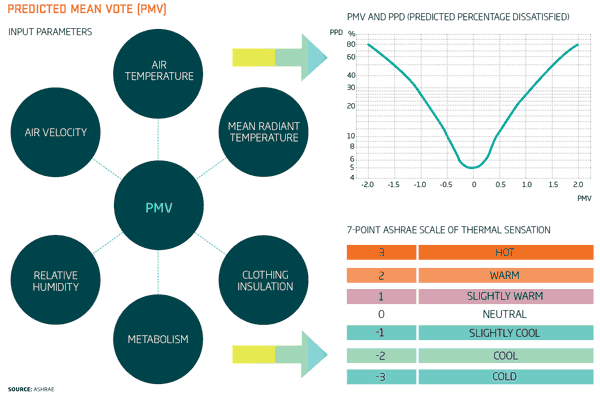The Comfort Zone
Conventional Thinking
In the 1960s and 1970s, Professor Povl Ole Fanger at the Technical University of Denmark pioneered the conventional theory of thermal comfort, which has shaped international standards for HVAC systems ever since. Hoping to determine the ideal environmental temperature at which people could maintain their internal body temperatures, Fanger placed his subjects in a so-called climate chamber. Controlling for three environmental variables (air velocity, mean radiant temperature, and relative humidity) and two personal variables (activity levels and clothing insulation), he varied the temperatures within the chamber and calculated the degree at which most people felt no temperature difference between themselves and the surrounding environment, a state known as "thermally neutral." The people in the study were essentially passive objects-providing feedback regarding the conditions Fanger established in the climate chamber but not able to make any adjustments of their own.
From these kinds of laboratory-based studies, Fanger developed the Predicted Mean Vote (PMV) index and the Predicted Percentage Dissatisfied (PPD) index. The former predicts the temperature at which most occupants will be satisfied and the latter predicts what portion of occupants will be unhappy with a particular set of temperature and conditions. The notion that one can determine (and maintain) an ideal temperature for most people within a controlled environment forms the basis of modern thermal comfort standards, including ASHRAE Standard 55, which was first published in 1966. The PMV-PPD indices still figure prominently in the most current version of the standard, published in 2010.
 |
Â
Although technically correct, the laboratory-staged research and the standards it subsequently spawned established acceptable indoor temperature ranges that are much more narrow than those that have been tolerated by human populations for millennia. Furthermore, the research and standards make the assumption that occupants wearing similar clothes and doing similar activities will be equally comfortable with the same indoor conditions no matter where they are in the world. In the rational pursuit of an ideal temperature for all, the effort lost sight of the variations and complexities of people's day-to-day realities in different cultures and climates.
Unfortunately, one negative consequence of this conventional theory of comfort has been the increase in mechanical air-conditioning worldwide to attain that "ideal" temperature range, accompanied by a global increase in fossil-fuel consumption to keep these systems operating.
The Adaptive Model
While the conventional theory, with its bias towards a more uniform and rigid temperature range, took hold and spread throughout modern building standards and industry practices, not everyone was convinced that this static, "one-size-fits-all" approach was necessary or even optimal. For example, studies undertaken in the 1970s by Humphreys and Fergus Nicol, now a professor at the Low Energy Architecture Research Unit (LEARN) of the London Metropolitan University, suggested that the indoor temperature preferred by occupants around the world varied according to the current outdoor temperature. In other words, during the hotter summer months, an office worker would prefer a warmer indoor temperature than he or she would in the winter.
As concern for indoor environmental quality and energy conservation grew towards the end of the 20th century, interest also began to grow among more researchers and practitioners to reexamine the thermal-comfort assumptions embedded in the current standards and explore alternative ways to achieve high indoor environmental quality without wasting precious resources. An indication of this shift occurred in August 1994 in Windsor, UK, where an international group convened to discuss thermal comfort at the first of what has become a periodic gathering called the Windsor Conferences. The conferences are sponsored by the Network for Comfort and Energy Use in Buildings (NCEUB) and more information can be found at nceub.commoncense.info.









